St Andrew's Anglican Church
Vulture Street, South Brisbane
J.W. Walker & Sons, London, 1884
Installed 1885 in temporary gallery T.C. Christmas, Brisbane
2 manuals, 16 speaking stops, mechanical action
Removed to present position in the nave, early 1911 B.B. Whitehouse & Co., Brisbane
Restored with additions 1961 Charles Dirksen Organ Co., Brisbane
Rebuilt and enlarged 1970 Laurie Pipe Organs, Melbourne
3 manuals, 30 speaking stops, electro-pneumatic action
Restoration commenced 2010 W.J. Simon Pierce, Brisbane
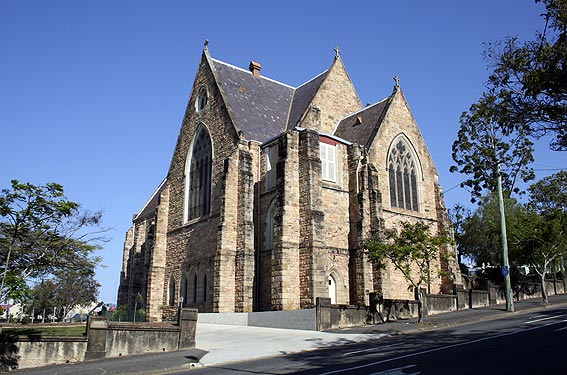
St Andrew's Anglican Church, South Brisbane
[Photograph by Trevor Bunning (September 2007)]
Historical and Technical Documentation by Geoffrey Cox
© OHTA 2007, 2014, 2020 (last updated November 2020)
Anglican services in South Brisbane were first conducted in St Thomas' Church, built in the 1850s on land granted in 1849 between Grey, Melbourne and Stanley Streets.1 The area was prone to flooding, and the construction of St Andrew's commenced on higher ground in 1878. The church is built of rusticated sandstone in Gothic Revival style. The original design, which included a tower and spire, was by Andrea Stombuco, an Italian architect who settled in Brisbane in the 1870s, but this was never completed. Financial constraints interrupted the building process even in the first phase (comprising the chancel, transepts and first bay of the nave), which was not re-commenced until 1882-83. The building was extended in 1887 to the design of H.W.K. Martin, and the nave was finally completed in 1931-32 under the supervision of the architect Lange L. Powell.2
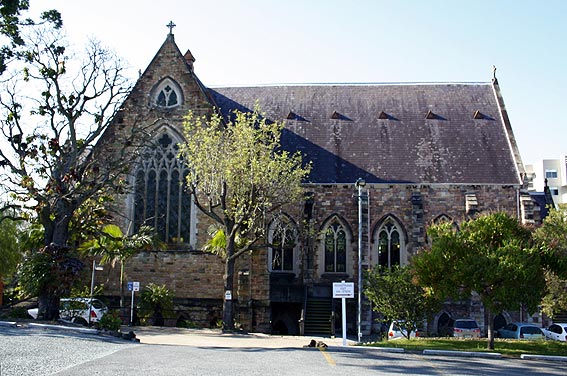
The completed nave of St Andrew's Church, South Brisbane
[Photograph by Trevor Bunning (September 2007)]
The opening and dedication of the original section of the building took place on Wednesday 6 June, 1883. A full choral service marked the occasion, the choir being assisted by those of various city churches, with Madame Mallalieu and Mr Willmore officiating at the organ (presumably a harmonium).3 The consecration of the building by Bishop Hale took place on the following Sunday,4 and a newspaper report around a month later shows that the purchase of a suitable pipe organ was high on the agenda for the congregation:
The Congregation of St. Andrew's Church of England, South Brisbane, having in view the purchase of an organ suitable for their church, were fortunate in securing the valuable and freely tendered services and advice of Mr Willmore, the well-known organist of All Saints, Brisbane, during his recent visit to England, in selecting the best description of instrument procurable for their requirements, resulting in the ordering of an organ from the firm of Walker and Sons, London, of the following specification, namely:-
1.
2.
3.
4.
5.
6.
7.
1.
2.
3.
4.
5.
6.
7.
8.
9.
1.
|
Great Organ, compass CC to G
Open Diapason
Dulciana, tenor C
{Stopped diapason bass
{Wald flute treble
Principal
Flute
Fifteenth
Swell Organ, compass CC to G
Double diapason
Horn diapason
Lieblich gedact
{Echo gamba
{Gedact bass
Vox angelica, ten[or] C
undulating with No 4
Octave
Mixture, three ranks
Horn
Hautboy
Pedal Organ, compass CCC to F
Bourdon
________
Total pipes ...
|
Pipes
56
44
56
56
56
56
56
56
56
56
44
56
168
56
56
30
___
958
|
8 ft
8 ft
8 ft
4 ft
4 ft
2 ft
16 ft
8 ft
8 ft
8 ft
8 ft
4 ft
8 ft
8 ft
16 ft
|
tone
[tone]
tone
tone
[tone]
|
3 Composition pedals to great
3 Composition pedals to swell
Couplers: Great to pedals, great to swell, swell to pedals
It is expected that the organ will be erected in the church and be in use before next Easter, and it may safely be predicted, from the specification and the makers' established fame for turning out superior instruments, that this will be one of the best in the city; and the energetic congregation of St. Andrew's is to be heartily congratulated on this their spirited undertaking.5

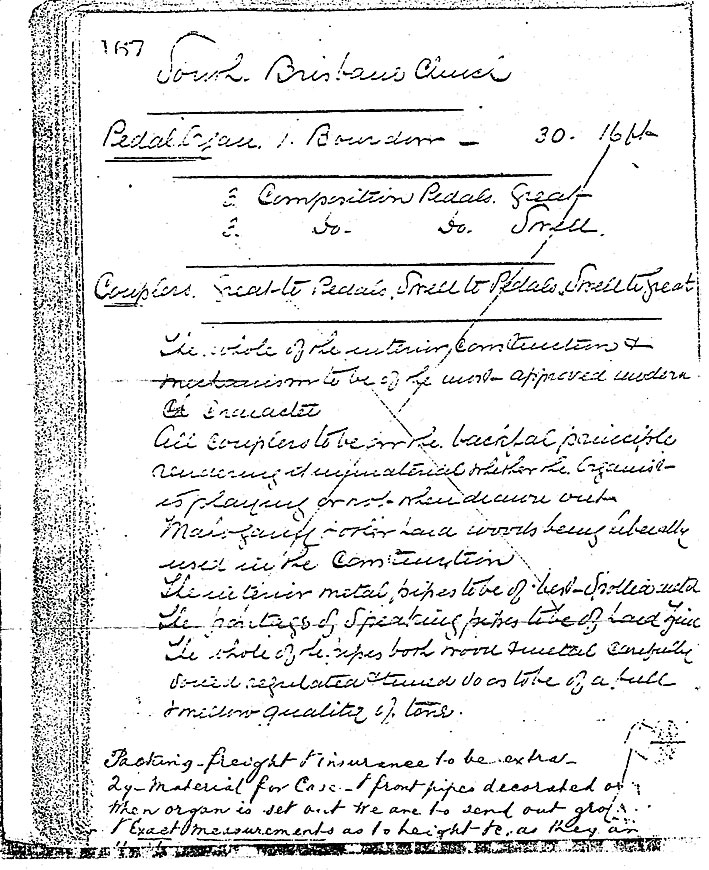
J.W. Walker & Sons Ledger Book E (1875-1884), pp. 166-67.
[J.W. Walker & Sons Ltd, Brandon, Suffolk]
The specification announced above corresponds with that recorded in the ledger of J.W. Walker & Sons, where it is listed as Job No 1186, and dated July 6th 1883.6
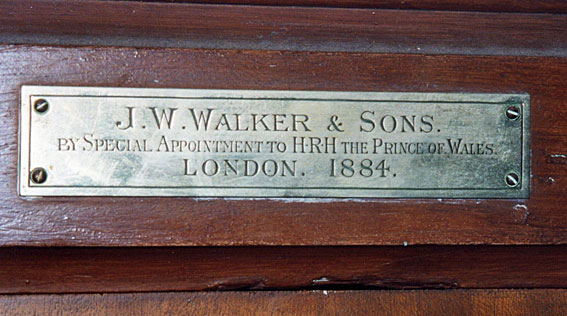
The builder's nameplate on the organ
[Photograph by Geoffrey Cox (September 2007)]
According to the records of the firm, the organ was not finished and shipped until December 1884,7 although there is at least one (perhaps overly hopeful) newspaper report of its expected arrival in Brisbane in September that year:
The new organ for St Andrew s Church, South Brisbane is expected to arrive in the R.M.S. Quetta, which arrived in the Bay yesterday. The new organ loft is now in course of erection in the church over the chief entrance and facing the chancel.8
A further newspaper report in December 1884 confirms, however, that the organ was not shipped until that month. It also reports that the instrument had been tested by the London organist Mr E.H. Turpin:
For some months past the congregation worshipping at St. Andrew's, South Brisbane, have been anxiously expecting the arrival of their new organ, for the reception of which a gallery has already been erected. Mr. T. M. King, treasurer of the organ fund, received a letter yesterday from Messrs. J. W. Walker and Sons, London, to whom was intrusted the construction of the instrument. They expressed a hope that it would be despatched by the steamer leaving London on the 12th December, and it might therefore be expected to arrive in Brisbane near the end of January. The organ on its completion was examined by the organist Mr. E. H. Turpin, the well-known London organist, who is secretary of the Royal College of Organists; Examiner Royal Academy of Music; College of Preceptors; Organist of Trinity College, &c. Mr. Turpin, in writing to Messrs. Walker and Sons, says:- "Allow me to express the complete satisfaction and pleasure I experienced in trying the new organ you have built for St. Andrew's, Brisbane. After trying the various stops and combinations I found the full swell, I think I am justified in saying, the most effective of its size of the very many I have heard. The crescendo and decrescendo effects were truly remarkable. The diapason work in both great and swell organ I noted to be extremely rich and sonorous, and the tone to be finely balanced and well built up to the louder effects. The delicate stops of the swell as Gamba and Vox Angelica are exquisitely voiced, and similarly the softer registers as Dulciana, Waldensian [sic] Flute and Flute of Great are very charming throughout the instrument. . . . I feel assured the organ will prove a most effective and serviceable instrument." The specification for this organ was drawn by Mr. T. Willmore, organist of All Saints', Brisbane, when in London last year, and the high opinion expressed by Mr. Turpin is a splendid testimonial to Mr. Wilmore's ability.9
The new instrument was opened at St Andrew's on Thursday 26 March 1885. A detailed account of the opening appeared in The Brisbane Courier the following day, including details of the gallery in which it was placed, and of the music performed on the occasion:
ST. ANDREW'S CHURCH ORGAN.
The new organ, which arrived from London a few weeks ago for St. Andrew's C.E., South Brisbane, was opened last night. The builders of the instrument are Messrs. J. W. Walker and Sons, the well-known organ builders of Tottenham Court-road, London. The specification was drawn by Mr. W. G. Willmore, and to some extent its construction went forward under his personal supervision in London, when on a visit to that city last year. The work of erection in Brisbane was carried out by Mr. T. C. Christmas, under the general supervision of Mr. Willmore. The organ, although not so large as some others in the colony, is regarded by competent judges as surpassed by none in sweetness of tone and power of the diapason. It consists of two complete manuals and a pedal organ. . .
[The specification follows here, as noted above]
The organ, the pipes of which are chastely decorated, has been erected in a specially-built gallery at the end of the church, and directly opposite the chancel. For several reasons it was also deemed expedient to transfer the choir from the chancel to this gallery. The dedication ceremonies last night were attended by a large congregation. The service was full choral and the choir did excellently. The following is the programme of music as announced: - Voluntary, andante, A major, Smart; versicles and responses, Tallis; Magnificat, "Nunc Dimittis," Berthold Tours; anthem, "Oh, Lord, How Manifold are Thy Works," Barnby; offertoire, andante, Baptiste; concluding voluntary, Hallelujah Chorus ("Messiah") performed by W. G. Willmore. Miss King, the organist of the church, presided at the organ during the service. This young lady's capabilities as a pedal organist were for the first time put to public test and were found to be admirable. In the opening voluntary and offertory Miss King displayed several of the various beautiful stops, much to the pleasure of those present. The incumbent, Rev. E. Meeres, was assisted by the Ven. Archdeacon Glennie and Rev. C. W. Houlbrook, the latter of whom preached from Psalm xcv, 1 to 3 verses, "O come let us sing unto the Lord. Let us make a joyful noise to the rock of our salvation." The preacher dwelt at length upon the necessity for really good Church music, and its power in keeping alive spiritual energy. He specially urged the infusion of fresh vigour to the magnifying of and praising God. A strong plea was put forward for due care and exactitude being exercised in the preparation of praise by church choirs.
The collection was devoted to the organ fund. The whole of the congregation remained in the church until the close of Mr. Willmore's brilliant performance of "The Hallelujah Chorus". The tone of the organ was generally much admired, but none of the stops more so than the beautiful vox angelica and the echo gamba. It is not unlikely that one or two organ recitals will be given in the church after Easter.10
A report of services on Easter Sunday (5 April) also referred to the new organ being played:
Among the organ voluntaries, none was more beautiful than an arrangement of "If with all your hearts," from Mendelssohn's "Elijah" in the performance of which some of the choice stops in the new organ were used.11
The installation date and details are confirmed by the fact that one of the pedal pallet boxes contains the inscription "T. C. Christmas, 1885".12 Walker's standard draw-stop console included a hitch-down lever swell pedal, with the draw-stops on non-angled jambs either side of the keyboards.13 This was one of the larger Walker instruments exported to Australia, slightly smaller than the one they built for St Stephen's, Newtown, NSW in 1875.14 The casework, however, is less elaborate than that for St Stephen's, comprising a single flat.
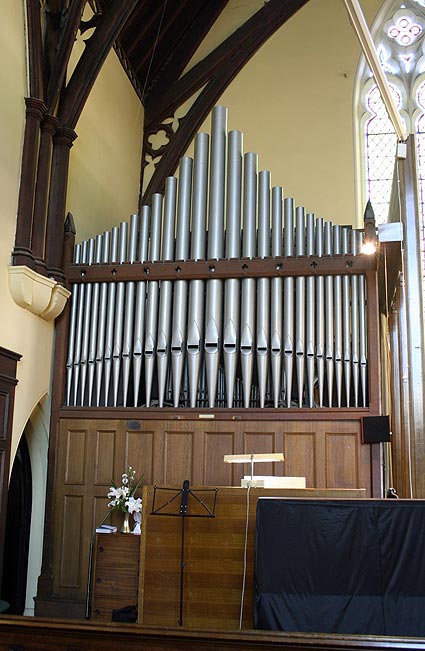
The J.W. Walker & Sons organ of 1884
[Photograph by Trevor Bunning (September 2007)]
Early in 1911, Messrs B.B. Whitehouse & Co. were instructed to remove the organ from the gallery to its present position adjacent to the chancel:
… we have been able to get the organ thoroughly renovated and overhauled,
as well as to have it removed and re-erected on the floor of the Church,
near the chancel and choir. It undoubtedly is a great improvement in every way.15
There were few changes to the instrument over a long period: A radiating-concave pedal board, modeled on that of the City Hall organ, was made by Mr B.J. Peel of South Brisbane,16 and fitted by Whitehouse Bros in 1934.17 Peel built an organ for his own residence in Vulture Street a few years later, and was a professional carriage builder.18 Whitehouse Bros maintained and tuned the instrument over several decades, and overhauled it in November 1944.19 At some time before c.1950, a tremulant was added to the Swell in memory of Agatha Taylor, the wife of Edgar W. Taylor who was organist of St Andrew's for some fifty years, 1898-1948.20
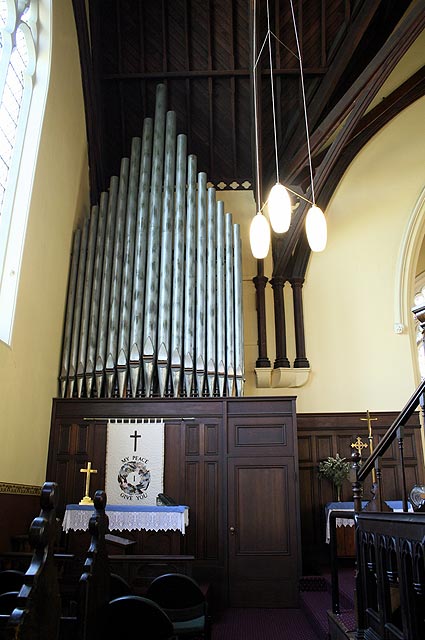
The 1961 Dirksen pedal additions
[Photograph by Trevor Bunning (September 2007)]
The first major alterations to the organ came in 1961, when the Charles Dirksen Organ Co of Brisbane added five stops (derived by extension from two ranks) to the Pedal Organ using direct electric action. These were placed on the opposite side of the chancel over the screened vestry:
Violone
Cello
Gedact
Flute
Quint
|
16
8
16
8
5-1/3
|
A
A
B
B
B
|
At the same time, Dirksen completely replaced the original 3-rank Swell Mixture (in which all of the ranks broke at middle C), and added a bass octave to the Dulciana (formerly tenor C) on electric action. He also added a Swell Super coupler using mechanical action, and fully restored the original mechanical playing action.21
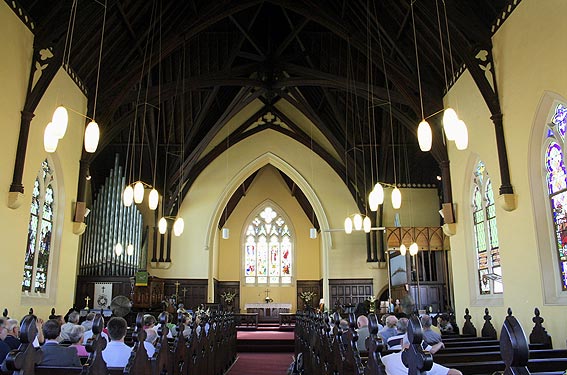
The organ viewed from the nave
[Photograph by Trevor Bunning (September 2007)]
The instrument was completely rebuilt and enlarged with the addition of a Choir division on the opposite side of the church in 1970 by Laurie Pipe Organs of Melbourne. Laurie supplied a new three-manual console, but retained the original Walker soundboards, converting them to electro-pneumatic action. Some of Dirksen's direct-electric action was also retained on the pedals.
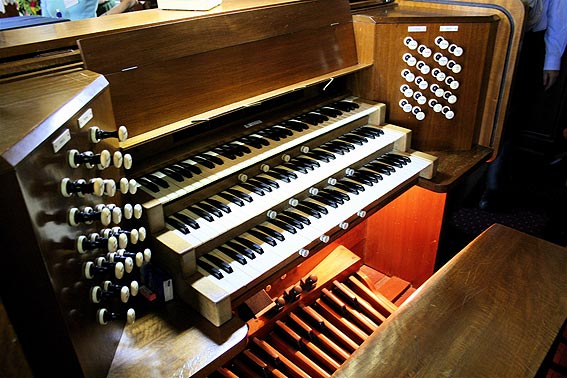
The 1970 Laurie console
[Photograph by Trevor Bunning (September 2007)]
GREAT
Open Diapason
Wald Flute
Principal
Rohr Flute
Twelfth
Fifteenth
SWELL
Double Diapason
Horn Diapason
Gedeckt
Echo Gamba
Vox Angelica (Ten. C)
Octave
Mixture 12.15.19
Trumpet
Hautboy
CHOIR (unenclosed)
Stopped Diapason
Dulciana
Dulcet
Recorder
Tierce
Larigot
Descant
Cremona
PEDAL
Subbass
Violone
Bourdon
Flute
Viola
Fifteenth
Cremona
COUPLERS
Swell to Pedal
Swell Octave to Pedal
Great to Pedal
Choir to Pedal
Swell to Great
Swell Octave to Great
Choir to Great
Swell to Choir
Swell Octave
Swell Unison Off
|
8
8
4
4
2-2/3
2
16
8
8
8
8
4
III
8
8
8
8
4
4
2
1-3/5
1
8
16
16
16
8
8
4
4
|
A
B
B
C
C
D
E
F
F
E
F
D
|
[1884]
[1884]
[1884]
[1884]
[1970]
[1884]
[1884]
[1884]
[1884]
[1884]
[1884]
[1884]
[1961] [given as 19.22.26 in Jefferson (1998), p. 249]
[1970?]
[1884]
[1970]
[1884]
[1970]
[1970]
[1970]
[1970]
[1970]
[1884]
[1961]
[1961]
[1961]
[1961]
[1961/1970]
[1970]
|
Electro-pneumatic action (and some direct electric action)
Detached draw-stop console
Balanced swell pedal
Compass: 61/30
3 adjustable pistons to Great Organ
3 adjustable pistons to Swell Organ
3 adjustable pistons to Choir Organ
3 adjustable pistons to Pedal Organ
Great & Pedal Pistons combined
Choir Tremulant
Radiating concave pedalboard22

Walker Great pipes and overpainted façade pipes
[Photograph by John Maidment (September 2007)]
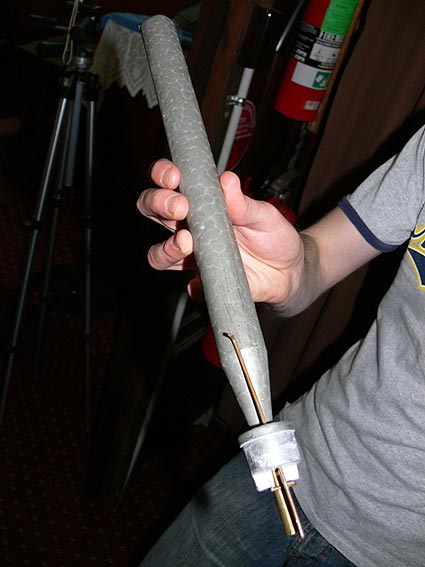
The so-called Cremona added by Laurie Pipe Organs, which is a
19th-century spotted-metal rank, possibly by Fincham.
[Photograph by John Maidment (September 2007)]
Damage to the electric contacts some years later was repaired by Laurie.23 The organ was overhauled and regulated in 1991 by W.J. Simon Pierce, including restoration of the Great soundboard.24
Proposals were developed around 2010 to restore this instrument to its original state with mechanical action and a new console in the style of the original, discarding the additions of 1961 and 1970. The first stage was completed in 2010 with the restoration of the original Swell and Great soundboards, the replacement of the 1960s slider seals, and the return of the Dulciana 8ft to its original location on the Great. A new mahogany cheek was made for the Great Fifteenth 2ft, and new lead conveyancing was made to wind the façade pipes.25


An interim revision of the stop jambs, with the Dulciana returned to the Great
Swell and Pedal (above); Choir and Great (below)
[Photographs by Geoffrey Cox (September 2014)]
______________________________________________________________________________
1 Edward R. Salisbury, 'The Pipe Organ at St Andrew's Anglican Church, South Brisbane', Organ Society of Queensland Newsletter, vol. 17, no. 5 (April 1990), pp. 5-9.
2 Queensland Heritage Council, Queensland Heritage Register, location 600304; The Heritage of Australia: The Illustrated Register of the National Estate (South Melbourne: Macmillan, 1981), 4/20.
3 The Brisbane Courier (Wednesday 6 June 1883), p. 5.
4 The Brisbane Courier (Monday 11 June 1883), p. 5.
5 The Brisbane Courier (Monday 16 July 1883), p. 5.
6 Walker Ledger Book E (1875-1884), pp. 166-67 [J.W. Walker & Sons Ltd, Brandon, Suffolk].
7 Personal communication to G. Cox from Alex Dingwall of J.W. Walker & Sons Ltd, Ruislip, UK, 29 July 1974. See also: Salisbury, op. cit, pp. 17-18.
8 The Brisbane Courier (24 September 1884), p. 8.
9 The Brisbane Courier (31 December 1884), p. 5.
10 The Brisbane Courier (27 March 1885), p. 5.
11 The Brisbane Courier (Monday 6 April 1885), p. 5.
12 E.W. Wetherell, Church Centenary Booklet, c.1961.
13 Collected Organ Specifications of Bernie Brohan (c.1952) & Notebooks of Mr. E.R. Salisbury.
14 Graeme Rushworth, Historic Organs of New South Wales: The Instruments, Their Makers and Players, 1791-1940 (Sydney: Hale & Iremonger, 1988), pp, 339, 341.
15 Report of the Churchwardens of St Andrew’s Church, South Brisbane, for the Year ending 31st March, 1911, cited by the Rev. John Arnold, Highgate Hill (Rector of St. Andrew’s, 1985-92). See also: Minutes of the St Andrew’s Prochial Church Council (25 January 1911 and 19 April 1911), cited by the Rev. John Arnold in Brisbane Diocese Archives.
16 Salisbury, op. cit., pp. 11-12.
17 Whitehouse Bros Ledger (1922-1940), p. 429.
18 Geoffrey Cox, 'A Residence Organ built by Mr E.J. Peel, Coachmaker of South Brisbane', Organ Australia, vol. 6, no. 4 (December 2010), pp. 11-13.
19 Whitehouse Bros Ledger (1940-1954), pp. 68-70, 392.
20 Salisbury, op. cit., pp. 11, 16.
21 1961 details supplied c.1973 to G. Cox by E.R. Salisbury (organist 1949-62); see also: Salisbury, op. cit, pp. 13-15.
22 Specification noted by G. Cox, 1971.
23 Bob Jefferson, Steve Laurie, Organ Builder: His Life and Work (Somers, Vic: [author], 1998), p. 79.
24 The Organ Voice, vol. 19, no. 3 (December 1991), p. 56.
25 W.J. Simon Pierce, Winter Newsletter (2010).












